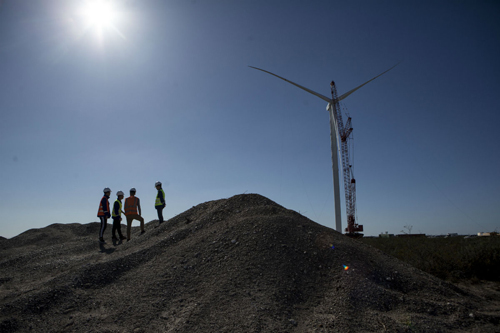Belt and Road
Your Present Location: PROGRAMS> Belt and RoadBelt and Road Initiative: New Logic for International Interactions
By Guan Zhaoyu Source: China Pictorial Published: 2019-4-25

March 26, 2019: Power China supports a local wind power project in Chubut, Argentina. The Belt and Road construction has helped participating countries achieve common development. Xinhua
It has been nearly six years since the Belt and Road Initiative was introduced in 2013. Over the past six years, the initiative has become an innovation in improving the global governance system.
Unlike zero-sum mentalities, the Belt and Road Initiative upholds dialogue and consultation, joint contribution, shared benefits, win-win cooperation, exchange and mutual learning, and aims to achieve maximal cooperation among relevant countries and promote political mutual trust, economic integration and people-to-people exchanges among the Belt and Road countries. It has mapped out a new logic and cooperative blueprint for state-to-state interactions.
Chinese President Xi Jinping stressed on several occasions in recent years that “the international situation is undergoing profound and complicated changes.” Indeed, the military conflicts in the Middle East, Brexit and the Donald Trump administration’s “America First” policy indicate that the world order established since the end of World War II is likely to collapse, implying dysfunction in the current global governance system.
Since the 18th National Congress of the Communist Party of China (CPC) in 2012, China has continued to uphold the strategy of mutually beneficial opening up. Following the principles of “extensive consultation, joint contribution and shared benefits,” it has actively striven to advance the reform and innovation of the international economic governance system, increase the say of developing countries in global affairs, and contribute Chinese wisdom to boosting world economic growth and improving global governance. Particularly, with the implementation of cooperative measures under the framework of the Belt and Road Initiative, China has played an increasingly important role in leading global economic governance.
Over the past six years, the Belt and Road Initiative has won support from a number of countries. To date, China has collaborated with countries participating in the initiative to build more than 80 overseas economic and trade cooperation zones, creating 244,000 jobs for those countries. The China-proposed Belt and Road Initiative helps expand the world market and create more jobs, contributes wisdom for promoting world development, and strongly supports the realization of the United Nations Millennium Development Goals and the 2030 Agenda for Sustainable Development. The initiative has broadened the road for developing countries—representing more than 80 percent of the world’s population—to achieve modernization and provided new options for countries and nations that aspire to develop faster while maintaining their independence.
The Belt and Road Initiative conforms to the national interests of various countries and the common interests of the international community. It is a matter of the future of the world. Over the past few years, the initiative has opened a new window to common development for the world. In fact, this is just a start. More than just a practical policy, the Belt and Road Initiative is also a forward-looking plan. As the construction of the Belt and Road moves forward, mankind will embrace a more convenient and interconnected world with fewer misunderstandings. With the opening of the 2nd Belt and Road Forum for International Cooperation, the initiative is set to be further carried out, bringing a greater sense of gain and happiness to people in involved countries.
The author is an associate research fellow at Chongyang Institute for Financial Studies, Renmin University of China.























































































 京公网安备 11010802037854号
京公网安备 11010802037854号





